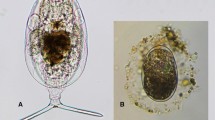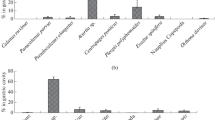Abstract
The feeding, egg production, and respiration rate of the dominant pteropod Limacina helicina have been studied in Russia’s Arctic seas. The sinking rates of fecal pellets and dead individuals have been measured to estimate their role in vertical carbon flux. As has been shown, the rate of ecophysiological processes taking place in the pteropods is higher than that of copepods, the main consumers of phytoplankton. The gut pigment content in Limacina (3084 ng ind–1 as a maximum) was two orders of magnitude higher than in copepods. The egg production rate in Limacina even without feeding reached 4000 eggs ind–1 versus 350–450 egg ind–1 typical of the dominant copepods even with excess food. A close correlation between the pteropod feeding rate and individual body weight was observed for Limacina rather than a correlation with food concentration. The experimentally estimated sinking rate of Limacina fecal pellets was 270 m day–1, higher than for most copepods. The sinking rate of dead pteropods reaches 2000 m day–1. According to the literature, discarded mucous feeding nets sink at a rate of 80 to 1080 m day–1. Evidently, pteropods play a significant role in biogeochemical cycles by accelerating sedimentation. High rates of all studied processes suggest that Limacina are an important component of plankton communities and play the most important role in trophodynamics at sites of their accumulation.
Similar content being viewed by others
References
N. M. Voronina, Ecosystems of Pelagial of the Southern Ocean (Nauka, Moscow, 1984) [in Russian].
A. V. Drits, E. G. Arashkevich, A. B. Nikishina, V. M. Sergeeva, K. A. Solovyev, and M. V. Flint, “Mesozooplankton grazing impact on phytoplankton in the northern regions of the Kara Sea in autumn,” Oceanology (Engl. Transl.) 55, 595–605 (2015).
M. V. Flint, S. G. Poyarkov, A. G. Timonin, and K. A. Soloviev, “The structure of the mesoplankton community in the area of the continental slope of the St. Anna Trough (Kara Sea),” Oceanology (Engl. Transl.) 55 (4), 583–594 (2015).
A. Accornero, C. Manno, F. Esposito, et al., “The vertical flux of particulate matter in the polynya of Terra Nova Bay. Part II. Biological components,” Antarct. Sci. 15, 175–188 (2003).
U. Båmstedt, D. J. Gifford, X. Irigoien, et al., “Feeding,” in ICES Zooplankton Methodology Manual, Ed. by R. Harris, (Academic, London, 2000), pp. 297–380.
N. Bednaršek, G. A. Tarling, S. Fielding, et al., “Population dynamics and biogeochemical significance of Limacina helicina antarctica in the Scotia Sea (Southern Ocean),” Deep Sea Res., Part II 59–60, 105–116 (2012).
K. S. Bernard, PhD Thesis (Rhodes University, Grahamstown, 2006).
K. S. Bernard and P.W. Froneman, “Trophodynamics of selected mesozooplankton in the west-Indian sector of the Polar Frontal Zone, Southern Ocean,” Polar Biol. 28, 594–606 (2005).
K. S. Bernard and P.W. Froneman, “The sub-Antarctic euthecosome pteropod, Limacina retroversa: Distribution patterns and trophic role,” Deep Sea Res., Part I 56, 582–598 (2009).
K. W. Bruland and M. W. Silver, “Sinking rates of fecal pellets from gelatinous zooplankton (salps, pteropods, doliolids),” Mar. Biol. 63, 295–300 (1981).
R. Collier, J. Dymond, S. M. Honjo, et al., “The vertical flux of biogenic and lithogenic material in the Ross Sea: moored sediment trap observations 1996–1998,” Deep Sea Res., Part II 47, 3491–3520 (2000).
S. Comeau, R. Jeffree, J.-L. Teyssié, et al., “Response of the Arctic pteropod Limacina helicina to projected future environmental conditions,” PLoS One 5 (6), e11362 (2010). doi 10.1371/journal.pone.0011362
R. J. Conover, “Reproductive cycle, early development, and fecundity in laboratory populations of the copepod Calanus hyperboreus,” Crustaceana 13, 61–72 (1967).
H. G. Dam and W. T. Peterson, “The effect of temperature on the gut clearance rate constant of planktonic copepods,” J. Exp. Mar. Biol. Ecol. 123, 1–14 (1988).
C. Gannefors, M. Böer, G. Kattner, et al., “The Arctic sea butterfly Limacina helicina: lipids and life strategy,” Mar. Biol. 147, 169–177 (2005).
W. D. Gardner, M. J. Richardson, and W. O. Smith, “Seasonal patterns of water column particulate organic carbon and fluxes in the Ross Sea, Antarctica,” Deep Sea Res., Part II 47, 3423–3449 (2000).
R. W. Gilmer and G. R. Harbison, “Morphology and field behavior of pteropod mollusks: feeding methods in the families Cavoliniidae, Limacinidae and Peraclididae (Gastropoda: Thecosomata),” Mar. Biol. 91, 47–57 (1986).
R. W. Gilmer and G. R. Harbison, “Diet of Limacina helicina (Gastropoda: Thecosomata) in Arctic waters in midsummer,” Mar. Ecol.: Progr. Ser. 77, 125–134 (1991).
H.-J. Hirche, “Egg production in the Arctic copepod Calanus glacialis: laboratory experiments,” Mar. Biol. 103, 311–318 (1989).
W. R. Howard, D. Roberts, A. D. Moy, et al., “Distribution, abundance and seasonal flux of pteropods in the Sub-Antarctic zone,” Deep Sea Res., Part II 58, 2293–2300 (2011).
P. D. Komar, A. P. Morse, L. F. Small, et al., “An analysis of sinking rates of natural copepod and euphausiid fecal pellets,” Limnol. Oceanogr. 26, 172–180 (1981).
K. N. Kosobokova and R. R. Hopcroft, “Diversity and vertical distribution of mesozooplankton in the Arctic’s Canada Basin,” Deep Sea Res., Part II 57, 96–110 (2010).
C. M. Lalli and R. W. Gilmer, Pelagic Snails: The Biology of Holoplanktonic Gastropod Mollusks (Stanford University Press, Stanford, CA, 1989).
C. M. Lalli and F. E. Wells, “Reproduction in the genus Limacina (Opisthobranchia: Thecosomata),” J. Zool. London 186, 95–108 (1978).
M. V. Lebour, “Limacina retroversa in Plymouth waters,” J. Mar. Biol. Ass. U.K. 18, 123–129 (1932).
D. L. Mackas and R. N. Bohrer, “Fluorescence analysis of zooplankton gut contents and investigation of diel feeding patterns,” J. Exp. Mar. Biol. Ecol. 25, 77–85 (1976).
D. L. Mackas and M. D. Galbraith, “Pteropod timeseries from the NE Pacific,” ICES J. Mar. Sci. 69 (3), 448–459 (2012). doi 10.1093/icesjms/fsr163
C. Manno, V. Tirelli, A. Accornero, et al., “Importance of the contribution of Limacina helicina faecal pellets to the carbon pump in Terra Nova Bay (Antarctica),” J. Plankton Res. 32 (2), 145–152 (2010).
J. Mauchline, The Biology of Calanoid Copepods (Academic, San Diego, 1998).
T. Noji, V. Ulrich, U. V. Bathmann, B. von Bodungen, et al., “Clearance of picoplankton-sized particles and formation of rapidly sinking aggregates by the pteropod, Limacina retroversa,” J. Plankton Res. 19 (7), 863–875 (1997).
E. A. Pakhomov and R. Perissinotto, “Mesozooplankton community structure and grazing impact in the region of the Subtropical Convergence south of Africa,” J. Plankton Res. 19, 675–691 (1997).
M. A. Paranjape, “The egg mass and veligers of Limacina helicina Phipps,” Veliger 10, 322–326 (1968).
A. Pasternak, E. Arashkevich, M. Reigstad, et al., “Dividing mesozooplankton into upper and lower size groups: Applications to the grazing impact in the Marginal Ice Zone of the Barents Sea,” Deep Sea Res., Part II 55, 2245–2256 (2008).
J. D. H. Strickland and T. R. Parsons, “A practical handbook of seawater analysis. Pigment analysis,” Bull. Fish. Res. Bd. Can. 167, 1–311 (1968).
M. Tsurumi, D. L. Mackas, F. A. Whitney, et al., “Pteropods, eddies, carbon flux, and climate variability in the Alaska Gyre,” Deep Sea Res., Part II 52, 1037–1053 (2005).
Author information
Authors and Affiliations
Corresponding author
Additional information
Original Russian Text © A.F. Pasternak, A.V. Drits, M.V. Flint, 2017, published in Okeanologiya, 2017, Vol. 57, No. 1, pp. 137–145.
Rights and permissions
About this article
Cite this article
Pasternak, A.F., Drits, A.V. & Flint, M.V. Feeding, egg production, and respiration rate of pteropods Limacina in Arctic seas. Oceanology 57, 122–129 (2017). https://doi.org/10.1134/S000143701701012X
Received:
Published:
Issue Date:
DOI: https://doi.org/10.1134/S000143701701012X




